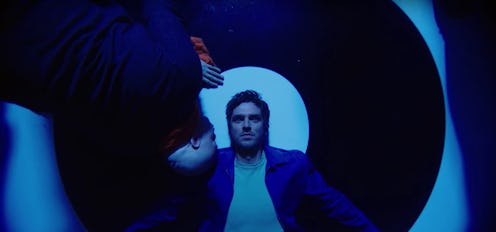
Spoilers for the "Chapter 11" episode of Legion. Viewers finally get some answers when the monk of the Mi-Go Order is officially introduced in "Chapter 11" of FX's superhero series after being glimpsed throughout the first two episodes. But of course those answers come with even more questions. What are the monk's powers on Legion? How is he infecting people, and why?
That's right: the teeth-chattering infection known as the Catalyst, which the team at Division III assumed to be the ominous work of the Shadow King, is revealed to have actually been caused by the monk.
At the beginning of the episode (after another Jon Hamm-narrated prologue about insanity that I'll circle back to in a minute), fans get to see the backstory of Amahl Farouk and the Mi-Go monks play out. After Farouk collapses into his dinner plate and dies — a reference to the psychic battle he waged with Charles Xavier in the middle of a crowded restaurant that ends with his body dead and his mind trapped in the astral plane — the monks take possession of his corpse, lower it into a hole in the floor of the monastery, seal it up, and go about their business.
Of course, this isn't the end of the matter. Over the years, the monks are apparently driven insane by the proximity of the Shadow King's corporeal form: breaking out into uncontrollable laughter, hanging themselves from the rafters, and — yes — chattering their teeth.
Eventually, the last remaining monk leaves the monastery, spreading the Catalyst wherever he goes, until he's picked up by Division III along with his victims in the club where David was found in the Season 2 premiere. It's revealed in "Chapter 11" that infiltrating Division III was the monk's goal all along: apparently the Mi-Go monks were told that, if anything were to go wrong, they should return to Division III to acquire a weapon they promised to build that would defeat the Shadow King once and for all. Only (whoops!) Division III apparently forgot to make the weapon as the years passed and they were faced with other, more pressing threats.
But none of that answers the question of how the monk is infecting people with the Catalyst. The aforementioned prologue posits a pseudo-scientific explanation: referencing such bizarre real-life psychological phenomenons as the Dancing Plague Of 1518, the Tanganyika Laughter Epidemic, and the Hindu Milk Miracle, it's implied that perhaps merely the stress of harboring the corpse of an evil omnipotent mutant causes an outbreak of good old-fashioned mass hysteria among the monks — hysteria that proves contagious once a monk brings it out into the world with him.
But is it really so simple? Is the Catalyst merely a psychological condition, or is the monk actually gifted with some sort of power by his proximity to the corpse of an evil omnipotent mutant? It's also revealed in "Chapter 11" that the minds of those afflicted by the Catalyst are trapped in a reality that caters to their core desire: a world without memory for Ptonomy; for Melanie, a game that allows her total control over an uncontrollable world.
The fact that the Catalyst locks its victims inside a reality that's specifically crafted to be attractive to them raises an interesting question. Given that David was originally found in a club full of infected people and deemed to be "immune" for some reason… could the entire season actually be playing out inside a fake reality the Catalyst has created inside his mind?
Fans should know by now never to take anything for granted on Legion, and this feels like exactly the kind of twist the show would pull. David won't be getting any answers out of the monk anytime soon, given that the monk kills himself by jumping off the roof of Division III rather than give up the location of the Shadow King's body. (…Or does he? If this is all in David's mind, then none of what's happened so far in Season 2 has been real.) But hopefully he'll get some answers from some source soon, to help make sense of the tangled web the show has woven.